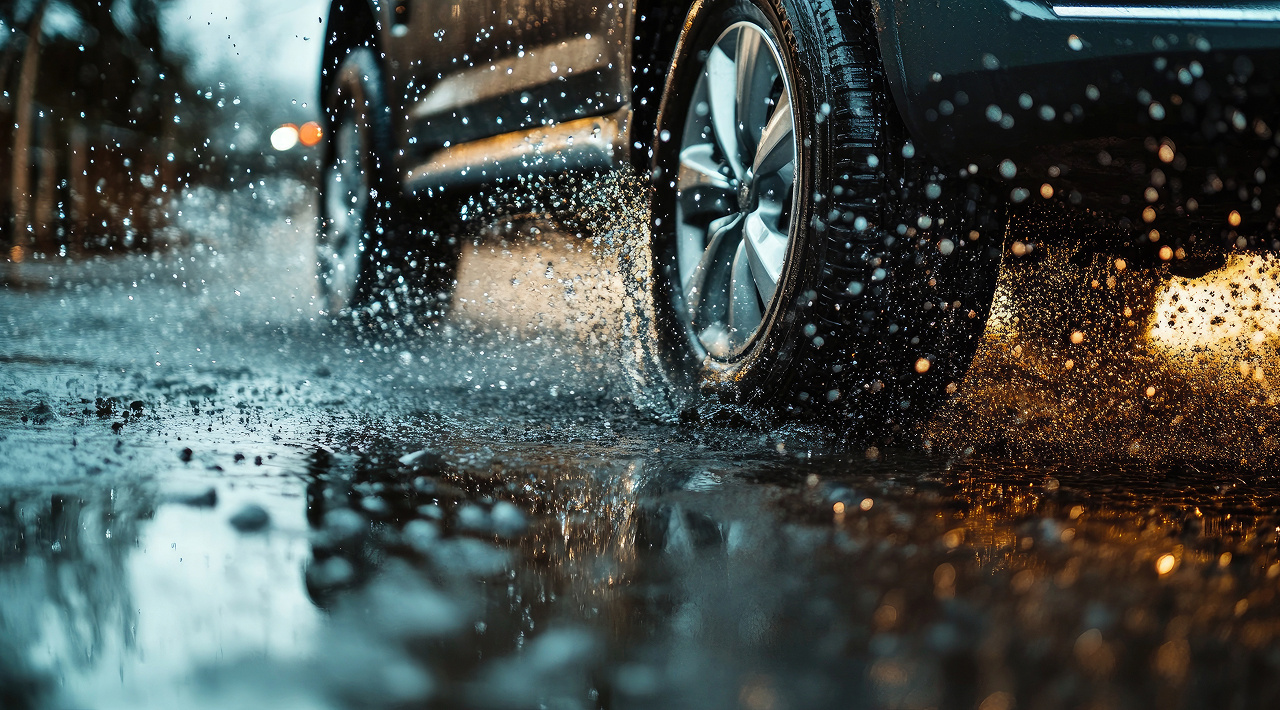As our weather patterns change, there is no doubt that we are experiencing more wet weather and, when it does rain, storms are often more sudden and ferocious than they used to be.

Such unexpected extreme weather can quickly lead to challenging driving conditions, so it is important that drivers know how to cope when water builds up on the road surface.
Aquaplaning, also known as hydroplaning, can be a problem if a layer of water builds up between a vehicle’s tyres and the road surface. An excess of surface water on the road can result in drivers losing control of their vehicles, posing a high accident risk to themselves and other road users.
Although we may not be able to change the weather, there are steps we can take behind the wheel to prevent us falling victim to aquaplaning. Read on to find out more.
Aquaplaning is a common issue in the UK and sadly it does make drivers more likely to be involved in a collision. When a layer of water builds up between the vehicle’s tyres and the road surface beneath, the tyres can no longer grip the road, causing a lack of traction that can result in a loss of control and a dangerous inability to steer, brake or accelerate.
Aquaplaning is often signalled to the driver by a sudden increase in engine noise and a sense that the steering has become lighter. This is sometimes accompanied by the back of the car drifting from side to side in a phenomenon known as “fishtailing”.
Aquaplaning can be a frightening experience for any driver.
Aquaplaning is caused by a sudden buildup of water on a road surface or pools of water if the surface is rutted or contains a significant number of potholes. The water needs to be at least 2.5mm deep for aquaplaning to occur. This depth is sufficient for tyres to lose their contact with the road.
A key way to prevent aquaplaning is to ensure that your vehicle’s tyres are in good condition and inflated to the correct pressure according to the manufacturer’s handbook.
Other ways in which drivers can prevent aquaplaning include switching off cruise control in heavy rain, driving at a sensible speed, being more prepared than usual for a potential problem, and avoiding any sudden actions such as abrupt braking. It is thought that a vehicle moving at 30mph in a couple of inches of water will maintain enough contact with the road surface to avoid aquaplaning, whereas one moving in the same amount of water at 50mph would be much less likely to stay in control. It is also important to remember that stopping distances can double in wet conditions.
One final tip is to follow the tracks made in the water by the car in front. Its tyres will have already displaced some of the rainwater, reducing the chance of aquaplaning in the car behind.
It also goes without saying that checking the weather conditions before you set out can prepare you for the potential for aquaplaning. Understand the warning signs and modify your driving technique and speed according to the conditions.
If the worst happens and you suddenly find yourself losing control of your car in wet conditions, there are a few steps you can take to minimise the potential for disaster.
If your car starts to aquaplane, try to remain calm. Don’t brake too hard and gently ease off the accelerator. Try to hold the steering wheel as straight as possible until you begin to regain control, when you can gently start braking to bring your speed down. Doing anything drastic could result in a skid and ultimately a collision.
To prevent aquaplaning it is vital that you keep your vehicle, particularly its tyres, in a safe and roadworthy condition. Every car leased through Leasys comes with a number of services as standard, such as roadside assistance and a dedicated driver helpline. For a small inflation-proof additional fee on top of your monthly rental payment, you can also benefit from a maintenance package that includes regular checks on your car and tyre replacements when necessary. The replacement of tyres due to fair wear and tear, including punctures, is covered. The legal minimum tyre tread is 1.6mm – however, Leasys allow replacement at 2.0mm.
To ensure UK wide cover, Leasys have partnered with Kwik Fit. Mobile and weekend replacement services are also available for your convenience.
Contact Leasys today to find out how its customer care team can help support you in taking a safer approach to driving.